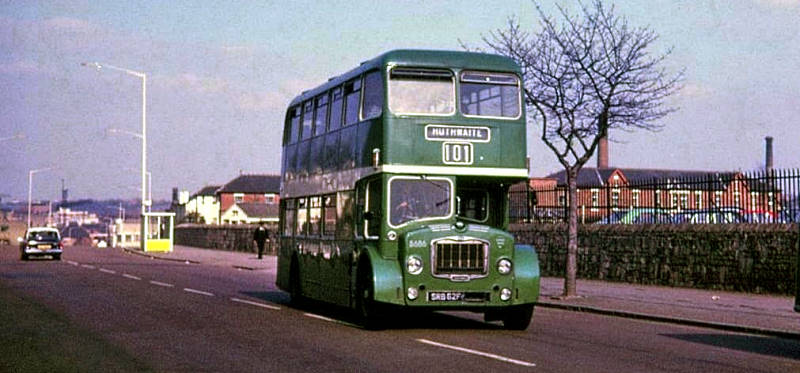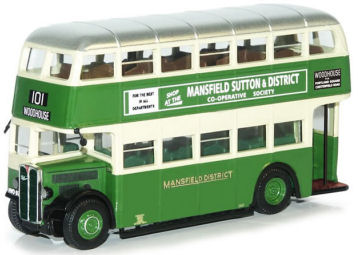A Hucknall History
Transport Back to the Future
Omnibus Derails Trams
Mansfield Tramways had eventually been afforded an amount of licensed privilege in order to maintain very regular services with competitively priced fares. Their plans to replace tram routes with omnibus services did seek similar council grants, allowing them an operating preference over existing rival bus companies. That was not good news for two well known Huthwaite owner operators.
Pratt Bros and Leah Bros wrote complaints heard by Sutton Council alongside similar objections raised July 1932 by Pinxton 'Bus Company Limited and Trent Motor Traction Company. They furthermore urged no monopoly should be granted against public interests. But it was the smaller Huthwaite brotherly companies which really lost out on the busiest public licensed routes.
Mansfield Traction Company

An impressive line up across Mansfield Market Place of 16 new AEC Regent buses is dated 18th September 1932. It was early that Sunday morning when all these numbered 101, headed off to replace the trams. That reported occasion had not however, been widely publicised. Only a limited number of invited dignitaries turned up at the Town Hall to witness such a significant historic event. Residents were barely awake when the Mayor enjoyed first official run through Sutton into Huthwaite. Returning just 35 minutes later had collected some surprised passengers, each being issued a complimentary ticket following his worships A000.

Taking over full railed route established by Mansfield & District Light Railway trams still connected Huthwaite services through Sutton-in-Ashfield, Mansfield, into Mansfield Woodhouse. Fact they were often grossly overloaded marked peak time popularity having enabled a mass of commuting workers to hold regular jobs away from home. Capturing when electric trams left Berry Hill October 9th, ended 28 years service with that final takeover.
Unquestionable success of the Mansfield trams providing much needed public transport had to accept those well worn slower vehicles had fallen well short of matching the comparably faster modern means of transport. Competition from other omnibus operators were already winning public favour introducing the flexibility and comfort of future public transport. Powerless as they were to stop this district changeover, Huthwaite Councillors did officially sanction this tramway replacement upon hearing factory girls voicing widely perceived complaints. Their letter to the Ministry of Transport requested reduced workpeoples fares should be continued for those having to make frequent hectic trips.



Without great public fanfare the Mansfield Traction Company thus began a familiar 101 bus service. Double deckers enabled shorter intermediate bus stops, and running every 10 minutes set standards aimed for ever since. They had a problem though when reaching the Huthwaite terminus. Unlike bidirectional trams, a bus obviously needs plenty of turning room. Main road position fronting a Sutton Road chapel restricted that unsafe manoeuvre.
Drivers soon realised it easier and indeed far less dangerous to circuit the vacant Huthwaite Market square a little further along. Concerns were raised February 1933 about unauthorised Market Place use, although only eliciting Urban councillors to not only judge the open area safely suited a new stop, but a practical cause finally meriting future tidiness.
Sheltered bus stops have since marked where the bus terminus stands aside the open Market Place.

Corgi models preserved memory of earlier open rear poled entry buses. An AEC Regent II in Nottinghamshire districts choice of green and cream livery is signed 101 Woodhouse. Only through comparison with tram rides could these ever be thought quietly comfortable. Alighting from rear a moving bus is lastly recalled c1975, before driver operated forward positioned doors were fully introduced barely helping to keep out winter draughts.
Britain was still gripped by an international postwar industrial depression when introducing this East Midland bus service. Taking up old tram lines created some much needed jobs. Councillors insisted they employed only local labour. Providing faster public transport would assist busy households to independently hold regular jobs wider afield. The 101 continued ferrying pit men into New Hucknall Colliery and single female hosiery workers staffing a huge Huthwaite CWS factory. After a second world war, a large number from Huthwaite also found newer employment commuting between numerous Sutton hosiery or textile factories raising district renown.


Removing an old air raid shelter reclaimed room inspiring a modernised layout. Incorporating the current bordered car park lastly situated the Main Street bus stand. Those changes also saw out the designated 101. Stagecoach took over a renumbered 1 route.
While constructing Chesterfield Road housing estates, Councillors considered Messrs. Leah Bros. requests to support application for a licence to run an accommodating service from Sutton via Chesterfield Road, Huthwaite, to Newton. There was no promising outcome. A much later Huthwaite No 2 Routemaster entering Clegg Hill Drive can only suggest an extended Mansfield & District route. For steeply distanced residents below Blackwell Road came a handy bus connection in blue and cream Derbyshire livery. Passing en route for Derby is suggested by a former D1, when starting weekly rides to Chesterfield College also aboard a C7.



Previous generations who'd attended West Notts. College and or sought Mansfield and Sutton entertainment venues recalled ease of connection on a winding circuit took by the Ebor bus. Apparently part of Chesterfield Corporation Transport, next registered upon Nottingham Road, Mansfield, when in direct competition with tram operators. A young Huthwaite man Arthur G. Herrod, from Barker Street had been employed as one of its bus conductors. His untimely 1933 death was mourned by many coworkers plus company manager Mr. Devoney. The Ebor Bus Company sold out to the larger competing Mansfield Traction Company from 1950.
School Runs
The Leah family of Huthwaite is already mentioned running an establishing bus service before derailing trams. Leah's coach trips went far beyond winning the first local school run. That need arose after parental uproar having to send children to Huthwaite Road senior classes. Their well remembered name thereafter became synonymous in Huthwaite long extending bus and coach journeys.
Shorter school runs typically prolong useful working life of high mileage buses. Next long term need safely ferrying even younger and greater numbers of Huthwaite scholars to an Ashfield Comprehensive in Kirkby started c1978.

 Alighting in Clegg Hill Drive and boarding the 2003 Main Street bus stop traced registrations to Redfern Travel operators.
Alighting in Clegg Hill Drive and boarding the 2003 Main Street bus stop traced registrations to Redfern Travel operators.
The 2021/22 timetables identify contract fulfilled by Butler Bros. Service 405 collected from Cross Lane, Columbia Street, Blackwell Road, Bonsor Crescent and The Green off Common Road. Service 409 from Huthwaite Library, with North St and George St en route through Sutton
Another timetabled 217 service from Kirkby Cross may also collect Huthwaite pupils from Common Road and Market Street for St Philip Neri Roman Catholic Academy Schools in Mansfield. Oddly, Huthwaite public transport never did directly connect Kirkby.
Stagecoach
Stagecoach took over regular Mansfield District general public bus timetables. Their colourful fleet still maintains use of the original Mansfield tram depot. Affordable preference towards personally owned transport largely accounts for dwindling numbers of regular bus passengers, just giving some obvious reason why single deckers now usually have sufficient seating through Huthwaite.







Stagecoach is one of the largest UK bus operators. Boasting a 600 vehicle fleet has met demands for local bus services across the country since 1980. Stagecoach East Midlands furthermore locally serve Gainsborough, Grimsby, Hull, Lincoln, Mansfield, Newark, Scunthorpe, Skegness, Spalding and Worksop. The primary number 1 service has since been extended to continue on through Huthwaite between fully connecting Mansfield Woodhouse Market Place with an Alfreton Bus Station in Derbyshire.
22 Feb 08 by Gary Elliott Updated 28 Feb 23
